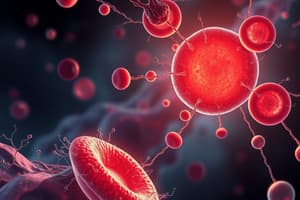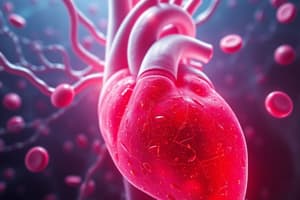Podcast
Questions and Answers
What is the diameter range of the dense purple particles in light microscopy?
What is the diameter range of the dense purple particles in light microscopy?
- 1-2 μm
- 6-8 μm
- 2-4 μm (correct)
- 4-6 μm
What structure is primarily found in the organelle zone of a platelet?
What structure is primarily found in the organelle zone of a platelet?
- Phospholipids
- Cytoplasm
- Lysosomes and mitochondria (correct)
- Glycocalyx
Which membrane lipid is primarily found in the outer plasma layer of platelets?
Which membrane lipid is primarily found in the outer plasma layer of platelets?
- Phosphatidylserine
- Phosphatidylcholine (correct)
- Phosphatidylethanolamine
- Cholesterol
What role does cholesterol play in the plasma membrane of platelets?
What role does cholesterol play in the plasma membrane of platelets?
Which component contributes to the adhesive properties of the glycocalyx in platelets?
Which component contributes to the adhesive properties of the glycocalyx in platelets?
What is the primary function of phospholipids in the plasma membrane of platelets?
What is the primary function of phospholipids in the plasma membrane of platelets?
What characterizes the shape of a resting platelet?
What characterizes the shape of a resting platelet?
What type of particles are observed using Romanowsky stain preparation in light microscopy?
What type of particles are observed using Romanowsky stain preparation in light microscopy?
What is the primary function of the submembrane area in platelets?
What is the primary function of the submembrane area in platelets?
Which component of platelets is described as the ‘control center’ for activation?
Which component of platelets is described as the ‘control center’ for activation?
What role do microfilaments play in platelet function?
What role do microfilaments play in platelet function?
What happens to actin in activated platelets when calcium levels increase?
What happens to actin in activated platelets when calcium levels increase?
How does the surface-connected canalicular system (SCCS) enhance platelet function?
How does the surface-connected canalicular system (SCCS) enhance platelet function?
What feature distinguishes the cylindrical structure of microtubules?
What feature distinguishes the cylindrical structure of microtubules?
What happens to platelets at lower temperatures?
What happens to platelets at lower temperatures?
Which of the following is NOT a function of the dense tubular system?
Which of the following is NOT a function of the dense tubular system?
What is the primary function of intermediate filaments like desmin and vimentin in platelets?
What is the primary function of intermediate filaments like desmin and vimentin in platelets?
How many alpha granules are typically found in a single platelet?
How many alpha granules are typically found in a single platelet?
Which of the following proteins is associated with platelet alpha granules but is not found in the cytoplasm?
Which of the following proteins is associated with platelet alpha granules but is not found in the cytoplasm?
What is the diameter of lysosomes in platelets?
What is the diameter of lysosomes in platelets?
What role does ATP play in platelet function?
What role does ATP play in platelet function?
Which of the following proteins is NOT associated with dense granules in platelets?
Which of the following proteins is NOT associated with dense granules in platelets?
What type of granules are known for containing coagulation proteins?
What type of granules are known for containing coagulation proteins?
Which of the following is a function of serotype in platelet dense granules?
Which of the following is a function of serotype in platelet dense granules?
P-selectin is primarily associated with which type of granule in platelets?
P-selectin is primarily associated with which type of granule in platelets?
Which two divalent cations support platelet activation and coagulation?
Which two divalent cations support platelet activation and coagulation?
Flashcards
Platelet Structure
Platelet Structure
Platelets are small, anucleate (without a nucleus) blood cells that play a vital role in blood clotting.
Platelet Shape
Platelet Shape
Platelets are typically discoid (disc-shaped) when inactive, but become irregular spheres with spiny extensions (pseudopods) upon activation.
Peripheral Zone
Peripheral Zone
Outermost layer of a platelet, containing the plasma membrane and glycocalyx.
Submembrane Area
Submembrane Area
Signup and view all the flashcards
Sol-Gel Zone
Sol-Gel Zone
Signup and view all the flashcards
Organelle Zone
Organelle Zone
Signup and view all the flashcards
Glycocalyx
Glycocalyx
Signup and view all the flashcards
Plasma Membrane
Plasma Membrane
Signup and view all the flashcards
Surface-Connected Canalicular System (SCCS)
Surface-Connected Canalicular System (SCCS)
Signup and view all the flashcards
Dense Tubular System (DTS)
Dense Tubular System (DTS)
Signup and view all the flashcards
Cytoskeleton
Cytoskeleton
Signup and view all the flashcards
Microfilaments
Microfilaments
Signup and view all the flashcards
Microtubules
Microtubules
Signup and view all the flashcards
α-Granules
α-Granules
Signup and view all the flashcards
Dense Granules
Dense Granules
Signup and view all the flashcards
Lysosomes
Lysosomes
Signup and view all the flashcards
Platelet activation
Platelet activation
Signup and view all the flashcards
Study Notes
Introduction to Platelet Structure and Function
- Light microscopy reveals dense, purple particles (2-4 μm diameter, anucleate) with light blue cytoplasm containing fine red-purple granules.
- Shape variations: discoid (inactive) and irregular sphere with spiny pseudopods (stimulated).
- Electron microscopy identifies four key zones within platelets:
- Peripheral Zone: platelets' outer membrane and structures.
- Submembrane Area: cell membrane and organelle separation.
- Sol-Gel Zone: matrix part of the platelet structure.
- Organelle Zone: contains granules, lysosomes, mitochondria, and is a metabolic center.
Resting Platelet Plasma Membrane
- Glycocalyx: Fluffy coat, 20-30 nm thickness, facilitates protein transport through endocytosis, with a net negative charge.
- Plasma membrane consists of a phospholipid and cholesterol bilayer, selectively permeable.
- Predominant phospholipids: phosphatidylcholine, sphingomyelin (outer layer), phosphatidylinositol, phosphatidylethanolamine, phosphatidylserine (inner layer).
- Cholesterol stabilizes the membrane and regulates transmembrane material passage.
- Glycoproteins and proteoglycans support various glycosylated receptors on the platelet surface.
Submembrane Area
- Located beneath the plasma membrane and contains organized filaments.
- Functions:
- Maintains discoid shape of platelets.
- Supports pseudopod formation.
- Modulates adhesion and clot retraction following activation.
Surface-Connected Canalicular System (SCCS)
- Sponge-like, intracellular system connected to the external environment.
- Functions:
- Stores hemostatic proteins.
- Enhances platelet-environment interactions.
- Provides delivery routes for substances and secretion of α-granule contents.
Dense Tubular System (DTS)
- Originates from rough endoplasmic reticulum, acts as the “control center” for activation.
- Functions:
- Sequesters calcium ions (Ca2+).
- Contains enzymes (phospholipase A2, cyclooxygenase, thromboxane synthetase) essential for activation.
Cytoskeleton: Microfilaments and Microtubules
- Microtubules (25 nm diameter) maintain discoid shape, control shape change, and support granule content expression; they become rigid at lower temperatures.
- Microfilaments made of actin ensure shape maintenance and enable pseudopod extension.
- Actin transitions from globular to filamentous in activated platelets as calcium levels rise.
- Intermediate filaments (Desmin, Vimentin) assist in shape maintenance and pseudopod extension.
Platelet Granules
- Platelets contain α-granules (50-80 per platelet), dense granules (2-7 per platelet), and lysosomes (300 nm diameter).
- α-Granules contain:
- Coagulation proteins: fibrinogen, Factor V, VWF.
- Noncoagulation proteins: β-thromboglobulin, EGF, PDGF.
- Membrane-bound proteins include P-selectin, GP IIb/IIIa, and PECAM-1.
- Dense granules predominantly store small molecules such as ADP (promotes aggregation), serotonin (vasoconstrictor), and calcium/magnesium.
- Lysosomes digest debris and vessel wall matrix components during platelet aggregation.
Studying That Suits You
Use AI to generate personalized quizzes and flashcards to suit your learning preferences.




